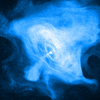CXC Home | Search | Help | Image Use Policy | Latest Images | Privacy | Accessibility | Glossary | Q&A
Tour of the Crab Nebula
Quicktime MPEG
The Crab Nebula is one of the best-known images ever taken by the Chandra X-ray Observatory. In X-ray light we can see a nebula of material that is powered by a rapidly rotating, highly magnetized neutron star at the center of the image. This particular Chandra image of the Crab shows how far the neutron star's influence is, creating these fingers and loops of radiation that extend far away from the neutron star. Looking at the Crab in other wavelengths, such as optical light from Hubble, seen here in green, and Spitzer's infrared view in red, we see a much different picture. The size of the X-ray image is smaller than the others because X-ray-emitting electrons radiate away their energy faster than the lower-energy electrons that emit optical and infrared light. Only by comparing these different wavelengths can we begin to see the total picture of the Crab Nebula.
[Runtime: 0:54]
(Credit: NASA/CXC/SAO/F.Seward et al)
Quicktime MPEG
The Crab Nebula is one of the best-known images ever taken by the Chandra X-ray Observatory. In X-ray light we can see a nebula of material that is powered by a rapidly rotating, highly magnetized neutron star at the center of the image. This particular Chandra image of the Crab shows how far the neutron star's influence is, creating these fingers and loops of radiation that extend far away from the neutron star. Looking at the Crab in other wavelengths, such as optical light from Hubble, seen here in green, and Spitzer's infrared view in red, we see a much different picture. The size of the X-ray image is smaller than the others because X-ray-emitting electrons radiate away their energy faster than the lower-energy electrons that emit optical and infrared light. Only by comparing these different wavelengths can we begin to see the total picture of the Crab Nebula.
[Runtime: 0:54]
(Credit: NASA/CXC/SAO/F.Seward et al)
Return to Crab Nebula (05 Nov 08)



